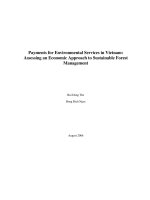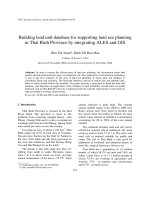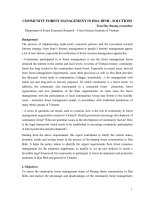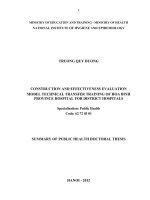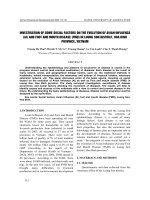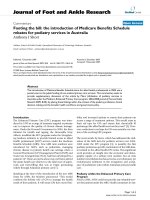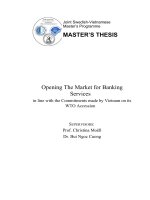Payments for ecosystem services in Hoa Binh province, Vietnam An institutional analysis
Bạn đang xem bản rút gọn của tài liệu. Xem và tải ngay bản đầy đủ của tài liệu tại đây (271.34 KB, 11 trang )
Ecosystem Services 22 (2016) 83–93
Contents lists available at ScienceDirect
Ecosystem Services
journal homepage: www.elsevier.com/locate/ecoser
Payments for ecosystem services in Hoa Binh province, Vietnam: An
institutional analysis
crossmark
⁎
Thi Thu Huong Trana,b, , Manfred Zellera, Diana Suhardimanc
a
b
c
Institute of Agricultural Sciences in the Tropics (Hans-Ruthenberg-Institute), University of Hohenheim, Wollgrasweg 43, 70599 Stuttgart, Germany
Vietnam National University of Agriculture, Trau Quy, Gia Lam, Ha Noi, Vietnam
International Water Management Institute, Southeast Asia Regional Office, P.O. Box 4199, Vientiane, Lao People's Democratic Republic
A R T I C L E I N F O
A BS T RAC T
Keywords:
Institutional design
Institutional performance
Institutional interplay
Ecosystem services
This study examines the institutional design and actual performance, of payments for ecosystem services (PES)
in Vietnam. Taking Payments for Forest Environmental Services Program (PFES Program) implementation in
Da Bac district, Hoa Binh province as a case study, it brings to light how PES program design and
implementation contributed to the central government's objectives to: (1) involve stakeholders in forest
management; (2) reduce the government's budget burden for forest protection; and (3) maintain political
control over forest resources. In Vietnam, the PFES Program is implemented in a top-down manner.
Participating households act as government-induced forest guards rather than forest owners. Incomplete
design at the central-level results in poorer performance at lower levels and, the lack of strategic management
makes it difficult to know whether the program has actually improved ecosystem services and forest
management. While the PFES Program complements other institutions at the national- and local-levels, some
institutional incompatibilities exist in terms of customary practices. It is unlikely, however, that these will
develop into an institutional conflict.
1. Introduction
Considered as an approach that could promote forest conservation
and support the economic development of the rural population,
payment for ecosystem services (PES) has received great attention in
both developed and developing countries (Wertz-Kanounnikoff and
Rankine, 2008; Corbera et al., 2009; Bac et al., 2014). This despite the
wide variation among many types of PES schemes (Wunder, 2005) and
different disciplinary groups (e.g., ecologists, biologists, economists,
and development practitioners) that promote it (McElwee, 2012).
The definition of PES introduced by Wunder (2005) is commonly
used and has since become a theoretical concept (Vatn, 2010). Building
on this definition, PES is newly defined as “voluntary transactions
between service users and service providers that are conditional on
agreed rules of natural resource management for generating offsite
services” (Wunder, 2015, p. 8).1 This new definition recognizes that
most agreements are constructed around resource-use proxies rather
than well-defined ecosystem services (Vatn, 2010). It also avoids using
the terms “buyer” and “seller”, which have been criticized for giving a
direct association with markets (Muradian et al., 2010) which may not
exist in the first place. While analyses on how PES operate have shown
that most schemes are rarely fully voluntary (Muradian et al., 2008;
Vatn et al., 2011) or conditional on verified additional provisions of
ecosystem services (Naeem et al., 2015), these features remain in
Wunder's new definition.
Scholars have highlighted the complex environmental, socio-political and economic contexts, and their implications for PES program
design and implementation (Porras et al., 2008; Sommerville et al.,
2009; Muradian et al., 2010). Muradian et al. (2010) use the different
contextual factors as means to explain the gap between the ideal type of
PES, or the way it has been envisioned as a concept, and its actual
implementation. Emphasizing on the institutional aspect of PES
implementation, and referring to Muradian et al����������������������������������������������������������������������������������������������������������������������������������������������������������������������������������������������������������������������������������������������������������������������������������������������������������������������������������������������������������������������������������������������������������������������������������������������������������������������������������������������������������������������������������������������������������������������������������������������������������������������������������������������������������������������������������������������������������������������������������������������������������������������������������������������������������������������������������������������������������������������������������������������������������������������������������������������������������������������������������������������������������������������������������������������������������������������������������������������������������������������������������������������������������������������������������������������������������������������������������������������������������������������������������������������������������������������������������������������������������������������������������������������������������������������������������������������������������������������������������������������������������������������������������������������������������������������������������������������������������������������������������������������������������������������������������������������������������������������������������������������������������������������������������������������������������������������������������������������������������������������������������������������������������������������������������������������������������������������������������������������������������������������������������������������������������������������������������������������������������������������������������������������������������������������������������������������������������������������������������������������������������������������������������������������������������������������������������������������������������������������������������������������������������������������������������������������������������������������������������������������������������������������������������������������������������������������������������������������������������������������������������������������������������������������������������������������������������������������������������������������������������������������������������������������������������������������������������������������������������������������������������������������������������������������������������������������������������������������������������������������������������������������������������������������������������������������������������������������������������������������������������������������������������������������������������������������������������������������������������������������������������������������������������������������������������������������������������������������������������������������������������������������������������������������������������������������������������������������������������������������������������������������������������������������������������������������������������������������������������������������������������������������������������������������������������������������������������������������������������������������������������������������������������������������������������������������������������������������������������������������������������������������������������������������������������������������������������������������������������������������������������������������������������������������������������������������������������������������������������������������������������������������������������������������������������������������������������������������������������������������������������������������������������������������������������������������������������������������������������������������������������������������������������������������������������������������������������������������������������������������������������������������������������������������������������������������������������������������������������������������������������������������������������������������������������������������������������������������������������������������������������������������������������������������������������������������������������������������������������������������������������������������������������������������������������������������������������������������������������������������������������������������������������������������������������������������������������������������������������������������������������������������������������������������������������������������������������������������������������������������������������������������������������������������������������������������������������������������������������������������������������������������������������������������������������������������������������������������������������������������������������������������������������������������������������������������������������������������������������������������������������������������������������������������������������������������������������������������������������������������������������������������������������������������������������������������������������������������������������������������������������������������������������������������������������������������������������������������������������������������������������������������������������������������������������������������������������������������������������������������������������������������������������������������������������������������������������������������������������������������������������������������������������������������������������������������������������������������������������������������������������������������������������������������������������������������������������������������������������������������������������������������������������������������������������������������������������������������������������������������������������������������������������������������������������������������������������������������������������������������������������������������������������������������������������������������������������������������������������������������������������������������������������������������������������������������������������������������������������������������������������������������������������������������������������������������������������������������������������������������������������������������������������������������������������������������������������������������������������������������������������������������������������������������������������������������������������������������������������������������������������������������������������������������������������������������������������������������������������������������������������������������������������������������������������������������������������������������������������������������������������������������������������������������������������������������������������������������������������������������������������������������������������������������������������������������������������������������������������������������������������������������������������������������������������������������������������������������������������������������������������������������������������������������������������������������������������������������������������������������������������������������������������������������������������������������������������������������������������������������������������������������������������������������������������������������������������������������������������������������������������������������������������������������������������������������������������������������������������������������������������������������������������������������������������������������������������������������������������������������������������������������������������������������������������������������������������������������������������������������������������������������������������������������������������������������������������������������������������������������������������������������������������������������������������������������������������������������������������������������������������������������������������������������������������������������������������������������������������������������������������������������������������������������������������������������������������������������������������������������������������������������������������������������������������������������������������������������������������������������������������������������������������������������������������������������������������������������������������������������������������������������������������������������������������������������������������������������������������������������������������������������������������������������������������������������������������������������������������������������������������������������������������������������������������������������������������������������������������������������������������������������������������������������������������������������������������������������������������������������������������������������������������������������������������������������������������������������������������������������������������������������������������������������������������������������������������������������������������������������������������������������������������������������������������������������������������������������������������������������������������������������������������������������������������������������������������������������������������������������������������������������������������������������������������������������������������������������������������������������������������������������������������������������������������������������������������������������������������������������������������������������������������������������������������������������������������������������������������������������������������������������������������������������������������������������������������������������������������������������������������������������������������������������������������������������������������������������������������������������������������������������������������������������������������������������������������������������������������������������������������������������������������������������������������������������������������������������������������������������������������������������������������������������������������������������������������������������������������������������������������������������������������������������������������������������������������������������������������������������������������������������������������������������������������������������������������������������������������������������������������������������������������������������������������������������������������������������������������������������������������������������������������������������������������������������������������������������������������������������������������������������������������������������������������������������������������������������������������������������������������������������������������������������������������������������������������������������������������������������������������������������������������������������������������������������������������������������������������������������������������������������������������������������������������������������������������������������������������������������������������������������������������������������������������������������������������������������������������������������������������������������������������������������������������������������������������������������������������������������������������������������������������������������������������������������������������������������������������������������������������������������������������������������������������������������������������������������������������������������������������������������������������������������������������������������������������������������������������������������������������������������������������������������������������������������������������������������������������������������������������������������������������������������������������������������������������������������������������������������������������������������������������������������������������������������������������������������������������������������������������������������������������������������������������������������������������������������������������������������������������������������������������������������������������������������������������������������������������������������������������������������������������������������������������������������������������������������������������������������������������������������������������������������������������������������������������������������������������������������������������������������������������������������������������������������������������������������������������������������������������������������������������������������������������������������������������������������������������������������������������������������������������������������������������������������������������������������������������������������������������������������������������������������������������������������������������������������������������������������������������������������������������������������������������������������������������������������������������������������������������������������������������������������������������������������������������������������������������������������������������������������������������������������������������������������������������������������������������������������������������������������������������������������������������������������������������������������������������������������������������������������������������������������������������������������������������������������������������������������������������������������������������������������������������������������������������������������������������������������������������������������������������������������������������������������������������������������������������������������������������������������������������������������������������������������������������������������������������������������������������������������������������������������������������������������������������������������������������������������������������������������������������������������������������������������������������������������������������������������������������������������������������������������������������������������������������������������������������������������������������������������������������������������������������������������������������������������������������������������������������������������������������������������������������������������������������������������������������������������������������������������������������������������������������������������������������������������������������������������������������������������������������������������������������������������������������������������������������������������������������������������������������������������������������������������������������������������������������������������������������������������������������������������������������������������������������������������������������������������������������������������������������������������������������������������������������������������������������������������������������������������������������������������������������������������������������������������������������������������������������������������������������������������������������������������������������������������������������������������������������������������������������������������������������������������������������������������������������������������������������������������������������������������������������������������������������������������������������������������������������������������������������������������������������������������������������������������������������������������������������������������������������������������������������������������������������������������������������������������������������������������������������������������������������������������������������������������������������������������������������������������������������������������������������������������������������������������������������������������������������������������������������������������������������������������������������������������������������������������������������������������������������������������������������������������������������������������������������������������������������������������������������������������������������������������������������������������������������������������������������������������������������������������������������������������������������������������������������������������������������������������������������������������������������������������������������������������������������������������������������������������������������������������������������������������������������������������������������������������������������������������������������������������������������������������������������������������������������������������������������������������������������������������������������������������������������������������������������������������������������������������������������������������������������������������������������������������������������������������������������������������������������������������������������������������������������������������������������������������������������������������������������������������������������������������������������������������������������������������������������������������������������������������������������������������������������������������������������������������������������������������������������������������������������������������������������������������������������������������������������������������������������������������������������������������������������������������������������������������������������������������������������������������������������������������������������������������������������������������������������������������������������������������������������������������������������������������������������������������������������������������������������������������������������������������������������������������������������������������������������������������������������������������������������������������������������������������������������������������������������������������������������������������������������������������������������������������������������������������������������������������������������������������������������������������������������������������������������������������������������������������������������������������������������������������������������������������������������������������������������������������������������������������������������������������������������������������������������������������������������������������������������������������������������������������������������������������������������������������������������������������������������������������������������������������������������������������������������������������������������������������������������������������������������������������������������������������������������������������������������������������������������������������������������������������������������������������������������������������������������������������������������������������������������������������������������������������������������������������������������������������������������������������������������������������������������������������������������������������������������������������������������������������������������������������������������������������������������������������������������������������������������������������������������������������������������������������������������������������������������������������������������������������������������������������������������������������������������������������������������������������������������������������������������������������������������������������������������������������������������������������������������������������������������������������������������������������������������������������������������������������������������������������������������������������������������������������������������������������������������������������������������������������������������������������������������������������������������������������������������������������������������������������������������������������������������������������������������������������������������������������������������������������������������������������������������������������������������������������������������������������������������������������������������������������������������������������������������������������������������������������������������������������������������������������������������������������������������������������������������������������������������������������������������������������������������������������������������������������������������������������������������������������������������������������������������������������������������������������������������������������������������������������������������������������������������������������������������������������������������������������������������������������������������������������������������������������������������������������������������������������������������������������������������������������������������������������������������������������������������������������������������������������������������������������������������������������������������������������������������������������������������������������������������������������������������������������������������������������������������������������������������������������������������������������������������������������������������������������������������������������������������������������������������������������������������������������������������������������������������������������������������������������������������������������������������������������������������������������������������������������������������������������������������������������������������������������������������������������������������������������������������������������������������������������������������������������������������������������������������������������������������������������������������������������������������������������������������������������������������������������������������������������������������������������������������������������������������������������������������������������������������������������������������������������������������������������������������������������������������������������������������������������������������������������������������������������������������������������������������������������������������������������������������������������������������������������������������������������������������������������������������������������������������������������������������������������������������������������������������������������������������������������������������������������������������������������������������������������������������������������������������������������������������������������������������������������������������������������������������������������������������������������������������������������������������������������������������������������������������������������������������������������������������������������������������������������������������������������������������������������������������������������������������������������������������������������������������������������������������������������������������������������������������������������������������������������������������������������������������������������������������������������������������������������������������������������������������������������������������������������������������������������������������������������������������������������������������������������������������������������������������������������������������������������������������������������������������������������������������������������������������������������������������������������������������������������������������������������������������������������������������������������������������������������������������������������������������������������������������������������������������������������������������������������������������������������������������������������������������������������������������������������������������������������������������������������������������������������������������������������������������������������������������������������������������������������������������������������������������������������������������������������������������������������������������������������������������������������������������������������������������������������������������������������������������������������������������������������������������������������������������������������������������������������������������������������������������������������������������������������������������������������������������������������������������������������������������������������������������������������������������������������������������������������������������������������������������������������������������������������������������������������������������������������������������������������������������������������������������������������������������������������������������������������������������������������������������������������������������������������������������������������������������������������������������������������������������������������������������������������������������������������������������������������������������������������������������������������������������������������������������������������������������������������������������������������������������������������������������������������������������������������������������������������������������������������������������������������������������������������������������������������������������������������������������������������������������������������������������������������������������������������������������������������������������������������������������������������������������������������������������������������������������������������������������������������������������������������������������������������������������������������������������������������������������������������������������������������������������������������������������������������������������������������������������������������������������������������������������������������������������������������������������������������������������������������������������������������������������������������������������������������������������������������������������������������������������������������������������������������������������������������������������������������������������������������������������������������������������������������������������������������������������������������������������������������������������������������������������������������������������������������������������������������������������������������������������������������������������������������������������������������������������������������������������������������������������������������������������������������������������������������������������������������������������������������������������������������������������������������������������������������������������������������������������������������������������������������������������������������������������������������������������������������������������������������������������������������������������������������������������������������������������������������������������������������������������������������������������������������������������������������������������������������������������������������������������������������������������������������������������������������������������������������������������������������������������������������������������������������������������������������������������������������������������������������������������������������������������������������������������������������������������������������������������������������������������������������������������������������������������������������������������������������������������������������������������������������������������������������������������������������������������������������������������������������������������������������������������������������������������������������������������������������������������������������������������������������������������������������������������������������������������������������������������������������������������������������������������������������������������������������������������������������������������������������������������������������������������������������������������������������������������������������������������������������������������������������������������������������������������������������������������������������������������������������������������������������������������������������������������������������������������������������������������������������������������������������������������������������������������������������������������������������������������������������������������������������������������������������������������������������������������������������������������������������������������������������������������������������������������������������������������������������������������������������������������������������������������������������������������������������������������������������������������������������������������������������������������������������������������������������������������������������������������������������������������������������������������������������������������������������������������������������������������������������������������������������������������������������������������������������������������������������������������������������������������������������������������������������������������������������������������������������������������������������������������������������������������������������������������������������������������������������������������������������������������������������������������������������������������������������������������������������������������������������������������������������������������������������������������������������������������������������������������������������������������������������������������������������������������������������������������������������������������������������������������������������������������������������������������������������������������������������������������������������������������������������������������������������������������������������������������������������������������������������������������������������������������������������������������������������������������������������������������������������������������������������������������������������������������������������������������������������������������������������������������������������������������������������������������������������������������������������������������������������������������������������������������������������������������������������������������������������������������������������������������������������������������������������������������������������������������������������������������������������������������������������������������������������������������������������������������������������������������������������������������������������������������������������������������������������������������������������������������������������������������������������������������������������������������������������������������������������������������������������������������������������������������������������������������������������������������������������������������������������������������������������������������������������������������������������������������������������������������������������������������������������������������������������������������������������������������������������������������������������������������������������������������������������������������������������������������������������������������������������������������������������������������������������������������������������������������������������������������������������������������������������������������������������������������������������������������������������������������������������������������������������������������������������������������������������������������������������������������������������������������������������������������������������������������������������������������������������������������������������������������������������������������������������������������������������������������������������������������������������������������������������������������������������������������������������������������������������������������������������������������������������������������������������������������������������������������������������������������������������������������������������������������������������������������������������������������������������������������������������������������������������������������������������������������������������������������������������������������������������������������������������������������������������������������������������������������������������������������������������������������������������������������������������������������������������������������������������������������������������������������������������������������������������������������������������������������������������������������������������������������������������������������������������������������������������������������������������������������������������������������������������������������������������������������������������������������������������������������������������������������������������������������������������������������������������������������������������������������������������������������������������������������������������������������������������������������������������������������������������������������������������������������������������������������������������������������������������������������������������������������������������������������������������������������������������������������������������������������������������������������������������������������������������������������������������������������������������������������������������������������������������������������������������������������������������������������������������������������������������������������������������������������������������������������������������������������������������������������������������������������������������������������������������������������������������������������������������������������������������������������������������������������������������������������������������������������������������������������������������������������������������������������������������������������������������������������������������������������������������������������������������������������������������������������������������������������������������������������������������������������������������������������������������������������������������������������������������������������������������������������������������������������������������������������������������������������������������������������������������������������������������������������������������������������������������������������������������������������������������������������������������������������������������������������������������������������������������������������������������������������������������������������������������������������������������������������������������������������������������������������������������������������������������������������������������������������������������������������������������������������������������������������������������������������������������������������������������������������������������������������������������������������������������������������������������������������������������������������������������������������������������������������������������������������������������������������������������������������������������������������������������������������������������������������������������������������������������������������������������������������������������������������������������������������������������������������������������������������������������������������������������������������������������������������������������������������������������������������������������������������������������������������������������������������������������������������������������������������������������������������������������������������������������������������������������������������������������������������������������������������������������������������������������������������������������������������������������������������������������������������������������������������������������������������������������������������������������������������������������������������������������������������������������������������������������������������������������������������������������������������������������������������������������������������������������������������������������������������������������������������������������������������������������������������������������������������������������������������������������������������������������������������������������������������������������������������������������������������������������������������������������������������������������������������������������������������������������������������������������������������������������������������������������������������������������������������������������������������������������������������������������������������������������������������������������������������������������������������������������������������������������������������������������������������������������������������������������������������������������������������������������������������������������������������������������������������������������������������������������������������������������������������������������������������������������������������������������������������������������������������������������������������������������������������������������������������������������������������������������������������������������������������������������������������������������������������������������������������������������������������������������������������������������������������������������������������������������������������������������������������������������������������������������������������������������������������������������������������������������������������������������������������������������������������������������������������������������������������������������������������������������������������������������������������������������������������������������������������������������������������������������������������������������������������������������������������������������������������������������������������������������������������������������������������������������������������������������������������������������������������������������������������������������������������������������������������������������������������������������������������������������������������������������������������������������������������������������������������������������������������������������������������������������������������������������������������������������������������������������������������������������������������������������������������������������������������������������������������������������������������������������������������������������������������������������������������������������������������������������������������������������������������������������������������������������������������������������������������������������������������������������������������������������������������������������������������������������������������������������������������������������������������������������������������������������������������������������������������������������������������������������������������������������������������������������������������������������������������������������������������������������������������������������������������������������������������������������������������������������������������������������������������������������������������������������������������������������������������������������������������������������������������������������������������������������������������������������������������������������������������������������������������������������������������������������������������������������������������������������������������������������������������������������������������������������������������������������������������������������������������������������������������������������������������������������������������������������������������������������������������������������������������������������������������������������������������������������������������������������������������������������������������������������������������������������������������������������������������������������������������������������������������������������������������������������������������������������������������������������������������������������������������������������������������������������������������������������������������������������������������������������������������������������������������������������������������������������������������������������������������������������������������������������������������������������������������������������������������������������������������������������������������������������������������������������������������������������������������������������������������������������������������������������������������������������������������������������������������������������������������������������������������������������������������������������������������������������������������������������������������������������������������������������������������������������������������������������������������������������������������������������������������������������������������������������������������������������������������������������������������������������������������������������������������������������������������������������������������������������������������������������������������������������������������������������������������������������������������������������������������������������������������������������������������������������������������������������������������������������������������������������������������������������������������������������������������������������������������������������������������������������������������������������������������������������������������������������������������������������������������������������������������������������������������������������������������������������������������������������������������������������������������������������������������������������������������������������������������������������������������������������������������������������������������������������������������������������������������������������������������������������������������������������������������������������������������������������������������������������������������������������������������������������������������������������������������������������������������������������������������������������������������������������������������������������������������������������������������������������������������������������������������������������������������������������������������������������������������������������������������������������������������������������������������������������������������������������������������������������������������������������������������������������������������������������������������������������������������������������������������������������������������������������������������������������������������������������������������������������������������������������������������������������������������������������������������������������������������������������������������������������������������������������������������������������������������������������������������������������������������������������������������������������������������������������������������������������������������������������������������������������������������������������������������������������������������������������������������������������������������������������������������������������������������������������������������������������������������������������������������������������������������������������������������������������������������������������������������������������������������������������������������������������������������������������������������������������������������������������������������������������������������������������������������������������������������������������������������������������������������������������������������������������������������������������������������������������������������������������������������������������������������������������������������������������������������������������������������������������������������������������������������������������������������������������������������������������������������������������������������������������������������������������������������������������������������������������������������������������������������������������������������������������������������������������������������������������������������������������������������������������������������������������������������������������������������������������������������������������������������������������������������������������������������������������������������������������������������������������������������������������������������������������������������������������������������������������������������������������������������������������������������������������������������������������������������������������������������������������������������������������������������������������������������������������������������������������������������������������������������������������������������������������������������������������������������������������������������������������������������������������������������������������������������������������������������������������������������������������������������������������������������������������������������������������������������������������������������������������������������������������������������������������������������������������������������������������������������������������������������������������������������������������������������������������������������������������������������������������������������������������������������������������������������������������������������������������������������������������������������������������������������������������������������������������������������������������������������������������������������������������������������������������������������������������������������������������������������������������������������������������������������������������������������������������������������������������������������������������������������������������������������������������������������������������������������������������������������������������������������������������������������������������������������������������������������������������������������������������������������������������������������������������������������������������������������������������������������������������������������������������������������������������������������������������������������������������������������������������������������������������������������������������������������������������������������������������������������������������������������������������������������������������������������������������������������������������������������������������������������������������������������������������������������������������������������������������������������������������������������������������������������������������������������������������������������������������������������������������������������������������������������������������������������������������������������������������������������������������������������������������������������������������������������������������������������������������������������������������������������������������������������������������������������������������������������������������������������������������������������������������������������������������������������������������������������������������������������������������������������������������������������������������������������������������������������������������������������������������������������������������������������������������������������������������������������������������������������������������������������������������������������������������������������������������������������������������������������������������������������������������������������������������������������������������������������������������������������������������������������������������������������������������������������������������������������������������������������������������������������������������������������������������������������������������������������������������������������������������������������������������������������������������������������������������������������������������������������������������������������������������������������������������������������������������������������������������������������������������������������������������������������������������������������������������������������������������������������������������������������������������������������������������������������������������������������������������������������������������������������������������������������������������������������������������������������������������������������������������������������������������������������������������������������������������������������������������������������������������������������������������������������������������������������������������������������������������������������������������������������������������������������������������������������������������������������������������������������������������������������������������������������������������������������������������������������������������������������������������������������������������������������������������������������������������������������������������������������������������������������������������������������������������������������������������������������������������������������������������������������������������������������������������������������������������������������������������������������������������������������������������������������������������������������������������������������������������������������������������������������������������������������������������������������������������������������������������������������������������������������������������������������������������������������������������������������������������������������������������������������������������������������������������������������������������������������������������������������������������������������������������������������������������������������������������������������������������������������������������������������������������������������������������������������������������������������������������������������������������������������������������������������������������������������������������������������������������������������������������������������������������������������������������������������������������������������������������������������������������������������������������������������������������������������������������������������������������������������������������������������������������������������������������������������������������������������������������������������������ive expenses incurred by commune officials for PFES,
10% was distributed to village funds, and the remaining 80% went to
households (amount to about 656,000 VND (US$ 25.5) per household
per year). A similar distribution of payments occurred in Co1 and Da2
villages. In Co1 village, the commune and village governments each
kept 5% of the total PFES money and villagers received 90% (about
299,000 VND (US$ 11.6) per household). In Da2 village, the total
amount of PFES money paid to the village was an average of 11 million
VND (US$ 428.2) per year, of which 90% was given equally to
households (about 113,000 VND (US$ 4.4) per household) and the
remaining 10% was given to the commune level for certifying documents and participating in the provincial implementing agencies’
monitoring and verification of forest protection activities by households on the ground.
3.2.5. Management
At the central-level, the MARD has not yet introduced any requirements for monitoring forest quality, soil erosion, or water regulation,
even though PFES targets each of these ecosystem services. The
monitoring and evaluation system is described in Circular 20, issued
by the MARD to guide PFES validation procedures (Ministry of
Agriculture and Rural Development, 2012a), refers only to the maintenance of existing forest cover as a proxy for ecosystem services and to
final outcomes (Thuy et al., 2013).
Information sharing between the HB Fund and Hoa Binh hydropower plant (which represents service users) is limited to official
meetings and annual written reports on the collection and disbursement of PFES monies. The two official meetings held in 2012 and 2013
forced service users to make payments based on the law instead of
scientific evidence of positive impacts from forest protection activities
undertaken by upland farmers. Nonetheless, the Hoa Binh hydropower
plant urged the need to be informed as to whether the money they paid
90
Ecosystem Services 22 (2016) 83–93
T.T.H. Tran et al.
of sanctions is gradually increased according to the number of
violations. The fine reaches 500,000 VND (US$ 19.5) for the third
offence of damaged forest from uncontrolled livestock and the cow or
buffalo is killed in case of a fourth offence. Withholding PFES monies is
time sensitive since payments are made close to the New Year holiday.
Therefore, this is considered to be the heaviest penalty and is the most
effective rule for enforcing forest protection.
given two other plots which are located in another village's territory”
(TMCPC_6_4).
Future policies and programs in the forestry sector suggest that
PFES will continue to be financed. For example, the national project
Afforestation and Protection of the Headwater Protection Forest in the
Da river reservoir in 2015–2020 (Binh Hoa Provincial People’s
Committee, 2013c) that is currently being developed would cover all
of the villages that are currently under PFES. This implies that farmers
would financially benefit more for each hectare of protected forest. In
addition, with an available system of the FPDF, the national action
program Reduction of Green-house Gas Emissions through Efforts to
Reduce Deforestation and Forest Degradation, Sustainable
Management of Forest Resources, and Conservation and
Enhancement of Forest Carbon Stocks in 2011–2020 (Program
REDD+) (Government of Vietnam, 2012b) could be more effectively
implemented. The Program REDD+fund will be considered as part of
the VNFF and the provincial FPDF (Vietnam Forest Protection and
Development Fund, 2013). In Hoa Binh province, the authorities
believe that Program REDD+ will scale-up after its pilot project in
Cao Phong district.
Besides, our analysis suggests the existence of unidirectional
vertical interplay in which local forest management institutions at the
community level positively influence the implementation of PFES. The
role of village headman has helped to minimize transaction costs of
PFES program implementation on the ground. PFES implementing
officials are allowed to sign contracts for forest protection with village
headmen instead of having to sign individual contracts with thousands
of households who are forest owners.
Although the VFGG was formed to meet the requirement of
common forest protection under PFES, the inclusion of actors who
participate in this group must abide by the village common regulations,
to include village leaders as the group members. This enhances a higher
commitment to: forest protection, dispute resolution, and monitoring
and verification of implementing officials on the ground. The active
contribution of the VFGG further lowers transaction costs of implementing agencies. Similarly, the involvement of the provincial vicechairman and leaders of technical departments in the Provincial
Steering Committee for PFES aimed to easily and effectively mobilize
the contributions of different agencies. Accordingly, the Steering
Committee might use its political power to obtain data from the tax
department on the business outcomes of services users and to convince
services users in intra-provincial watersheds to be involved in PFES
payments, even if the central government has not introduced any
enforcement rules.
As expressed by an official from provincial department of forest
development: “In fact, forests are protected by the whole community.
Some households might have 5–7 ha each while others have just
2000–3000 m2. However, those that have little forest land cannot
spend all of their time in the forest to protect it. This is certainly
impossible for those that have a lot of forest land. Therefore, the
protection of the forest would not be possible if there were the absence
of the village common regulations and a lack of growing awareness
among farmers” (DFD_6_1). The village common regulations also
stipulate that cows and buffaloes must be well-controlled to minimize
conflicts of destroyed forest. In addition, villagers must get permission
from the village leadership and the Forest Protection Department to
extract a regulated volume of timber to build new houses.
Enforcement rules have not yet been introduced by the central
government. Instead, noncompliance of forest protection contracts is
enforced by strict sanctions at the community level. Depending on the
degree of the violation, these sanctions include being criticized by the
entire community in village meetings, not getting a health insurance
card, and receiving a lower PFES payment. For example, in Co1 village,
the fine imposed to the case of damaged forest due to a cow or buffalo is
200,000 VND (US$ 7.8) per offence and the fine is 2000 VND (US$
0.08)/m2 for deforestation to create a new field. In Da2 village, the level
4. Discussion and conclusions
Our study reveals that weak monitoring and evaluation of land
user's compliance on the ground and a strict benefit sharing mechanism that induced farmers to act as forest rangers rather real forest
owners, do not ensure the additionality of the PFES Program in the
long-term. While the absence of clearly defined ecosystem services in
the program brings to light the program's technical shortcoming, it also
reveals the government's main objectives to implement PFES. PFES
implementation in Vietnam has mainly contributed to the central
government's objective to: (1) involve more stakeholders in forest
management (which relates to the social target), (2) reduce the
government budget's burden for forest protection (which related to
the financial target), and (3) maintain political control over forest
resources (Wunder, 2005; Suhardiman et al., 2013).
Current shortcomings in PFES institutional design have reduced
PFES’ actual significance in several ways, potentially mimicking previous subsidy programs on forest protection (McElwee, 2012; Thuy
et al., 2013). First, as the provision of ecosystem services is evaluated
based on forest cover, this does not give a clear and accurate picture on
forest-generated ecosystem service delivery. On the ground, implementing agencies employ forest cover proxies as the basis to make
payments to forest owners. This action is identical to what occurred
under previous forest protection programs, such as Program 661
(Huong et al., 2014), thus implying that payments were made based
on participation of households in PFES schemes, rather than on
performance of services provided by the forest (Phuc et al., 2012).
Second, as the collection of the PFES fee is independent of the actual
performance of forest protection on the ground, this might hamper the
effectiveness of the PFES Program (Thuy et al., 2013; Corbera et al.,
2009). Third, PFES in Vietnam serves the role of “performance-based
forest-ranger salaries” (Wunder, 2005), as neither buyers/users nor
suppliers voluntarily enter into a PFES contract, the current rates were
not established based on a willingness to accept responsibility by forest
communities and thus do not reflect opportunity costs (Wunder, 2005;
Catacutan et al., 2011). Nevertheless, PFES has proved to perform
better than previous forest protection programs because of its inclusion
of commercial forests into the payments, which has brought more
benefits to farmers.
From an institutional interplay perspective, the findings show that
the PFES Program mainly complements other institutions at national
and local-levels. The program is especially compatible with the
objectives of the national Forestry Development Strategy 2006–
2020. However, the swidden cultivation method of ethnic groups
(e.g., Dao group) is viewed as a key modifier of forest land in the
province. Although incompatibilities exist, it is unlikely that these will
become an institutional conflict.
The study shows that while the design of operating rules is a topdown process, enforcement rules are a bottom-up process. Local
institutions have developed and applied regulations, while the central-level has not. Compliance of PFES payment contracts on the
ground is enforced by community institutions, not by the central
government. Although the deduction of PFES payments based on the
degree of the violation made by commune and village authorities goes
against the objectives of PFES, it is an effective tool, especially given
that payments are distributed before the New Year holiday. The
effectiveness of this rule is further enhanced in communities where
PFES payments are larger than payments from previous forest protec91
Ecosystem Services 22 (2016) 83–93
T.T.H. Tran et al.
the Prime Minister on Vietnam Forestry Development Strategy 2006–2020. Ha Noi,
Vietnam.
Government of Vietnam, 2008b. Decree No. 05/2008/ND-CP dated January 14, 2008 of
the Government on Forest Protection and Development Funds. Ha Noi, Vietnam.
Government of Vietnam, 2010. Decree No. 99/2010/ND-CP dated September 24, 2010
of the Govenrment on Policy for Payments for Forest Environmental Services. Ha
Noi, Vietnam.
Government of Vietnam, 2012a. Decision No.57/QD-TTg dated January 9, 2012 of the
Prime Minister on Forest Protection and Development Plan 2011–2020. Ha Noi,
Vietnam.
Government of Vietnam, 2012b. Decision No. 799/QD-TTg dated June 27, 2012 of the
Prime Minister on National Action Plan for REDD+, 2011–2020. Ha Noi, Vietnam.
Binh Hoa Provincial People’s Committee, 2011a. Decision No. 2234/QD-UBND dated
November 16, 2011 of the Chairman on Establishing Provincial Steering Commitee
for the Implementation of the Payments for Forest Environmental Services Program
in Hoa Binh province. Hoa Binh, Vietnam.
Binh Hoa Provincial People’s Committee, 2011b. Decision No. 2642/QD-UBND dated
December 31, 2011 of the Chairman on the Establishment of Hoa Binh Forest
Protection and Development Fund. Hoa Binh, Vietnam.
Binh Hoa Provincial People’s Committee, 2012. Decision No. 1904/QD-UBND dated
December 12, 2012 of the Chairman on K-coefficient in the Implementation of the
Payments for Forest Environmental Services Program in Hoa Binh province. Hoa
Binh, Vietnam.
Binh Hoa Provincial People’s Committee, 2013a. Decision No. 155/QD-UBND dated
February 6, 2013 of the Chairman on Approving the Proposal to Implement the
Payments for Forest Environmental Services Program in the Watershed of Hoa Binh
Hydropower Plant. Hoa Binh, Vietnam.
Binh Hoa Provincial People’s Committee, 2013b. Decision No. 2008/QD-UBND dated
August 23, 2013 of the Chairman on the Implementation of Payments for Forest
Environmental Services in the Watershed of Hoa Binh Hydropower Plant. Hoa Binh,
Vietnam.
Binh Hoa Provincial People’s Committee, 2013c. Document No. 578/UBND-NNTN dated
June 19, 2013 of the Chairman on Project on Afforestation and Protection of the
Headwater Protection Forest in the Da River Reservoir in 2015–2020. Hoa Binh,
Vietnam.
Hoa Binh Provincial Union of Science and Technology Associations, 2010. The livelihood
of the local people after 30 years in the resettlement region along the Da river. In:
Proceedings of the Workshop on Effectiveness of State Policies on the Lives of
Resettled People in the Resettlement Region Along the Da river, Hoa Binh, Vietnam.
Huber-Stearns, H.R., Goldstein, J.H., Cheng, A.S., Toombs, T.P., 2015. Institutional
analysis of payments for watershed services in the western United States. Ecosyst.
Serv. 16, 83–93.
Huong, T.T.T., Zeller, M., Hoanh, C.T., 2014. The ‘Five Million Hectare Reforestation
Program’ in Vietnam: an analysis of its implementation and transaction costs, a case
study in Hoa Binh province. Q. J. Int. Agric. 53 (4), 341–375.
Legrand, T., Froger, G., Le Coq, J.-F., 2013. Institutional performance of payments for
environmental services: an analysis of the Costa Rican program. For. Policy Econ. 37,
115–123.
Ly, N.T.Y., 2013. Evaluating the Pilot Implementation of Payment for Forest
Environmental Services in Lam Dong, Vietnam. Economy and Environment Program
for Southeast Asia (EEPSEA), Tanglin, Singapore.
McElwee, P.D., 2012. Payments for environmental services as neoliberal market-based
forest conservation in Vietnam: panacea or problem? Geoforum 43 (3), 412–426.
Meshack, C.K., Ahdikari, B., Doggart, N., Lovett, J.C., 2006. Transaction costs of
community-based forest management: empirical evidence from Tanzania. Afr. J.
Ecol. 44 (4), 468–477.
Ministry of Agriculture and Rural Development, 2012a. Circular No.20/2012/TTBNNPTNT dated May 7, 2012 of the Minister on Procedures for Verification of
Forest Protection Performance and Making Payments for Forest Environmental
Services. Ha Noi, Vietnam.
Ministry of Agriculture and Rural Development, 2012b. Decision No. 3003/QD-BNNTCLN dated November 29, 2012 of the Minister on the Declaration of Forest Areas in
the Watersheds Covering Territory in Two or More Provinces as the Basis for Policy
on Payments for Forest Environmental Servces. Ha Noi, Vietnam.
Ministry of Agriculture and Rural Development, 2012c. Forest Sector Development
Report 2011: Serving FSSP Annual Plenary Meeting, 1 March 2012. Ha Noi,
Vietnam.
Ministry of Agriculture and Rural Development, 2013. Decision No. 2092/QD-BNNTCLN dated September 12, 2013 of the Minister on Adjustment of Respective Forest
Areas Belonging to Hoa Binh province in the Watershed of Hoa Binh Hydropower
Plant. Ha Noi, Vietnam.
Muradian, R., Corbera, E., Pascual, U., Kosoy, N., May, P.H., 2010. Reconciling theory
and practice: an alternative conceptual framework for understanding payments for
environmental services. Ecol. Econ. 69 (6), 1202–1208.
Muradian, R., Martinez-Tuna, M., Kosoy, N., Perez, M., Martinez-Alier, J., 2008.
Institutions and the Performance of Payments for Water-Related Environmental
Services. Lessons from Latin America. Development Research Institute, Tilburg
University, Tilburg, Netherlands.
Naeem, S., Ingram, J., Varga, A., Agardy, T., Barten, P., Bennett, G., Bloomgarden, E.,
Bremer, L., Burkill, P., Cattau, M., 2015. Get the science right when paying for
nature’s services. Science 347 (6227), 1206–1207.
Nga, D.T., 2014. Payments for forest environmental services in Vietnam: Historical
development and challenges. In: Presentation to a Workshop on “Challenges in
Benefit Sharing and Livelihood Improvement with Water Storage Development”,
Vientiane, Lao PDR.
North, D.C., 1990. Institutions, Institutional Change and Economic Performance.
tion programs since farmers can use the larger amount of money for
large investments.
The PFES Program is not a one-size-fits-all solution for conservation, primarily because it does not yet have sufficient mechanisms to
tackle the underlying drivers of deforestation (Pagiola, 2008; McElwee,
2012). There is the need to involve several programs across various
sectors simultaneously to mitigate pressure on forests. The inclusion of
sustainable finance and the promotion of an effective service supply,
good governance, strong institutions (law enforcement, monitoring and
control, etc.), and civil society participation are general preconditions
for successful ecosystem management and are not specific to a
particular PFES scheme (Wertz-Kanounnikoff and Rankine, 2008).
Overall, PFES is more meaningful to the poor and in remote areas
where there is little chance for off-farm employment. Furthermore,
payments from PFES are more significant in places where there is a
higher average amount of forest land per household. An official
provided his concluding thoughts on the effects of PFES in Hoa Binh
province, saying, “PFES coverage includes four districts and a little
area inside Hoa Binh city out of ten districts in the province. Among
localities implementing PFES, the program is likely significant to Da
Bac – which contains the most remote areas. In Cao Phong district,
for example, farmers are not eager for PFES because one can work as
an orange picker and earn 100,000 VND (US$ 3.9) per day, while
efforts spent on forest protection of one hectare per year provides a
similar amount of money” (MB2_6_2).
Acknowledgements
The authors would like to thank the project ‘Opportunities for
economic incentives to promote sustainable land and water management in the slopping lands of South and Southeast Asia’, as funded by
the Federal Ministry for Economic Cooperation and Development in
Germany, for its support of the research presented in this article. We
would also like to thank the Soil and Fertilizer Research Institute in
Vietnam for its assistance with the data collection activities and
logistics support required during the field research. We deeply
appreciate the hospitality of officials and villagers in Hoa Binh
province, Vietnam and their kindness for spending time with us during
the interviews.
References
Asian Development Bank, 2014. Scaling up Payments for Forest Environmental Services
in Vietnam: Lessons and Insights from Quang Nam. Mandaluyong, Philippines.
Bac, D.V., Catacutan, D.C., Ha, H.M., 2014. Importance of national policy and local
interpretation in designing payment for forest environmental services scheme for the
Ta Leng river basin in Northeast Vietnam. Environ. Nat. Resour. Res. 4 (1), 39–53.
Catacutan, D.C., Ha, H.M., Sen, H., Luan, T.D., 2011. Moving Beyond Pilots: A Review of
Lessons Learnt in Payments for Forest Ecosystem Services (PFES) in Vietnam.
World Agroforestry Center.
Corbera, E., Kosoy, N., Tuna, M.M., 2007. Equity implications of marketing ecosystem
services in protected areas and rural communities: case studies from Meso-America.
Glob. Environ. Change 17 (3), 365–380.
Corbera, E., Soberanis, C.G., Brown, K., 2009. Institutional dimensions of payments for
ecosystem services: an analysis of Mexico’s carbon forestry programme. Ecol. Econ.
68 (3), 743–761.
Da Bac District Department of Agriculture and Rural Development, 2011. Report No.
231/BC-NN & PTNT dated November 1, 2011 of the Head on District’s Agriculture
and Forestry Production in 2011. Da Bac district People’s Committee, Hoa Binh,
Vietnam.
Engel, S., Pagiola, S., Wunder, S., 2008. Designing payments for environmental services
in theory and practice: an overview of the issues. Ecol. Econ. 65 (4), 663–674.
Farley, J., Costanza, R., 2010. Payments for ecosystem services: from local to global.
Ecol. Econ. 69 (11), 2060–2068.
Gómez-Baggethun, E., Muradian, R., 2015. In markets we trust? Setting the boundaries
of market-based instruments in ecosystem services governance. Ecol. Econ. 117,
217–224.
Government of Vietnam, 2006. Decision No. 672/QD-TTg dated April 28, 2006 of the
Prime Minister on the Implementation of Project on Cadastral Mapping, and Project
on Issuance of the Forest Land Use Rights Certificate in 8 Provinces in the Northern
Mountainous Areas and the North Central Coast, and in 9 provinces in the Central
Coast and the Southeast. Ha Noi, Vietnam.
Government of Vietnam, 2007. Decision No. 18/2007/QD-TTg dated February 5, 2007 of
92
Ecosystem Services 22 (2016) 83–93
T.T.H. Tran et al.
Vatn, A., Barton, D., Lindhjem, H., Movik, S., Ring, I., Santos, R., 2011. Can Markets
Protect Biodiversity? An Evaluation of Different Financial Mechanisms. Department
of International Environment and Development Studies, Noragric. Norwegion
University of Life Sciences, Norway. Naragric Report.
Vietnam Forest Protection and Development Fund, 2013. In: Proceedings Workshop on
Payment for Forest Environmental Services in Vietnam - Status and Solutions. Ha
Noi, Vietnam.
Vietnam Forest Protection and Development Fund, 2014a. Payments for Forest
Environmental Services (PFES) in Vietnam: Findings From Three Year of
Implementation. Vietnam Forest Protection and Development Fund. Ha Noi,
Vietnam. Available at 〈 (accessed 15.1.16).
Vietnam Forest Protection and Development Fund, 2014b. Report [no number] on the
Implementation of the Payments for Forest Environmental Services Program in 2013
and on Planning for the Implementation in 2014. Ha Noi, Vietnam.
Vietnam National Assembly, 2004. Forest Protection and Development Law 2004. Ha
Noi, Vietnam.
Vietnam National Assembly, 2008. Biodiversity Law 2008. Ha Noi, Vietnam.
Wertz-Kanounnikoff, S., Rankine, H., 2008. How Can Governments Promote Strategic
Approached to Payments for Environmental Services (PES). An Exploratory Analysis
for the Case of Vietnam. The Institute for Sustainable Development and
International Relations (IDDRI), Paris, France.
Winrock International, 2011. Payment for Forest Environmental Services: A Case Study
on Pilot Implementation in Lam Dong Province, Vietnam from 2006 to 2010. Little
Rock, USA.
Wunder, S., 2005. Payments for Environmental Services: Some Nuts and Bolts.
Occasional Paper No. 42. Center for International Forestry Research, Bogor,
Indonesia.
Wunder, S., 2015. Revisiting the concept of payments for environmental services. Ecol.
Econ. 117, 234–243.
Cambridge University Press, Cambridge, United Kingdom.
Pagiola, S., 2008. Payments for environmental services in Costa Rica. Ecol. Econ. 65 (4),
712–724.
J., Peters, 2008. The pilot payments for forest environmental services policy in Vietnam
and PES pilot sites in the Dong Nai river basin. In: Presentation to IWLEARN
Regional Workshop on Payments for Environmental Services. Ha Noi, Vietnam.
Phuc, T.X., Dressler, W.H., Mahanty, S., Thuy, P.T., Zingerli, C., 2012. The prospects for
payment for ecosystem services (PES) in Vietnam: a look at three payment schemes.
Hum. Ecol. 40 (2), 237–249.
Porras, I.T., Grieg-Gran, M., Neves, N., 2008. All That Glitters: A Review of Payments for
Watershed Services in Developing Countries. International Institute for
Environment and Development (IIED).
Prokofieva, I., Gorriz, E., 2013. Institutional analysis of incentives for the provision of
forest goods and services: an assessment of incentive schemes in Catalonia (northeast Spain). For. Policy Econ. 37, 104–114.
Sommerville, M.M., Jones, J.P., Milner-Gulland, E., 2009. A revised conceptual
framework for payments for environmental services. Ecol. Soc. 14 (2), 34.
Suhardiman, D., Wichelns, D., Lestrelin, G., Hoanh, C.T., 2013. Payments for ecosystem
services in Vietnam: market-based incentives or state control of resources? Ecosyst.
Serv. 6, 64–71.
Tan, N.Q., 2011. Payment for Environmental Services in Vietnam: An Analysis of the
Pilot Project in Lam Dong Province. Institute for Global Environmental Strategies
(IGES), Hayama, Japan.
Thuy, P.T., Bennett, K., Phuong, V.T., Brunner, J., Dung, L.N., Tien, N.D., 2013.
Payments for Forest Environmental Services in Vietnam: From Policy to Practice.
Center for International Forestry Research, Bogor, Indonesia.
Thuy, P.T., Moeliono, M., Hien, N.T., Tho, N.H., Hien, V.T., 2012. The Context of REDD
+ in Vietnam: Drivers, Agents and Institutions. Center for International Forestry
Research, Bogor, Indonesia.
Vatn, A., 2010. An institutional analysis of payments for environmental services. Ecol.
Econ. 69 (6), 1245–1252.
93

